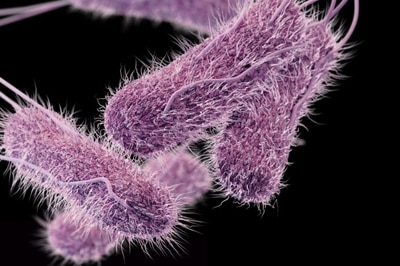
From CDC-Authored Genomics Publication Database
This database contains CDC-authored publications in public health genomics including infectious diseases, newborn screening, reproductive health, genetic testing, cancer, chronic diseases, birth defects and developmental disabilities, environmental and occupational health as well as laboratory, bioinformatics and statistical methods.
- Preliminary Incidence and Trends of Infections with Pathogens Transmitted Commonly Through Food - Foodborne Diseases Active Surveillance Network, 10 U.S. Sites, 2006-2017.

Marder Mph Ellyn P et al. MMWR. Morbidity and mortality weekly report 2018 Mar (11) 324-328 - Statistical adjustment of culture-independent diagnostic tests for trend analysis in the Foodborne Diseases Active Surveillance Network (FoodNet), USA.

Gu Weidong et al. International journal of epidemiology 2018 Mar - Benchmark datasets for phylogenomic pipeline validation, applications for foodborne pathogen surveillance.

Timme Ruth E et al. PeerJ 2017 e3893 - Foodborne cryptosporidiosis.

Ryan Una et al. International journal for parasitology 2017 Nov - National Antimicrobial Resistance Monitoring System: Two Decades of Advancing Public Health Through Integrated Surveillance of Antimicrobial Resistance.

Karp Beth E et al. Foodborne pathogens and disease 2017 Aug - Pulsotype Diversity of Clostridium botulinum Strains Containing Serotypes A and/or B Genes.

Halpin Jessica L et al. Foodborne pathogens and disease 2017 Jul - Incidence and Trends of Infections with Pathogens Transmitted Commonly Through Food and the Effect of Increasing Use of Culture-Independent Diagnostic Tests on Surveillance - Foodborne Diseases Active Surveillance Network, 10 U.S. Sites, 2013-2016.

Marder Ellyn P et al. MMWR. Morbidity and mortality weekly report 2017 Apr (15) 397-403 - A Comparative Analysis of the Lyve-SET Phylogenomics Pipeline for Genomic Epidemiology of Foodborne Pathogens.

Katz Lee S et al. Frontiers in microbiology 2017 375 - Utility of Combining Whole Genome Sequencing with Traditional Investigational Methods To Solve Foodborne Outbreaks of Salmonella Infections Associated with Chicken: A New Tool for Tackling This Challenging Food Vehicle.

Crowe Samuel J et al. Journal of food protection 2017 Mar 654-660 - Metagenomics of two severe foodborne outbreaks provides diagnostic signatures and signs of co-infection not attainable by traditional methods.

Huang Andrew D et al. Applied and environmental microbiology 2016 Nov - Characteristics of Clusters of Salmonella and Escherichia coli O157 Detected by Pulsed-Field Gel Electrophoresis that Predict Identification of Outbreaks.

Jones Timothy F et al. Foodborne pathogens and disease 2016 Sep - Evaluation of library preparation methods for Illumina next generation sequencing of small amounts of DNA from foodborne parasites.

Nascimento Fernanda S et al. Journal of microbiological methods 2016 Aug - Turtles as a Possible Reservoir of Nontyphoidal Salmonella in Shanghai, China.

Zhang Jianmin et al. Foodborne pathogens and disease 2016 Jun - An Economic Evaluation of PulseNet: A Network for Foodborne Disease Surveillance.

Scharff Robert L et al. American journal of preventive medicine 2016 Feb - Norovirus genotype profiles associated with foodborne transmission, 1999-2012.

Verhoef Linda et al. Emerging Infect. Dis. 2015 Apr 21(4) 592-9 - Evaluating the occurrence of Escherichia albertii in chicken carcass rinses by PCR, Vitek analysis, and sequencing of the rpoB gene.

Lindsey Rebecca L et al. Appl. Environ. Microbiol. 2015 Mar 81(5) 1727-34 - Suitability of the molecular subtyping methods intergenic spacer region, direct genome restriction analysis, and pulsed-field gel electrophoresis for clinical and environmental Vibrio parahaemolyticus isolates.

Lüdeke Catharina H M et al. Foodborne pathogens and disease 2014 Jul (7) 520-8 - Atypical Listeria monocytogenes serotype 4b strains harboring a lineage II-specific gene cassette.

Lee Sangmi et al. Appl. Environ. Microbiol. 2012 Feb 78(3) 660-7 - Multi-locus variable number tandem repeat analysis for investigation of the genetic association of Clostridium difficile isolates from food, food animals and humans.

Marsh Jane W et al. Anaerobe 2011 Aug 17(4) 156-60 - Subtyping Salmonella enterica serovar enteritidis isolates from different sources by using sequence typing based on virulence genes and clustered regularly interspaced short palindromic repeats (CRISPRs).

Liu Fenyun et al. Appl. Environ. Microbiol. 2011 Jul 77(13) 4520-6






















.png)











No hay comentarios:
Publicar un comentario